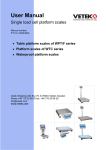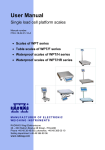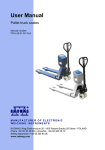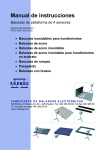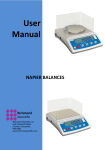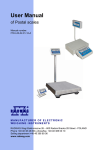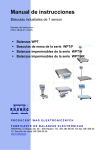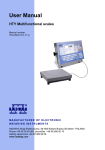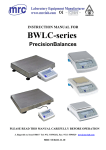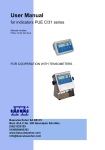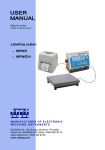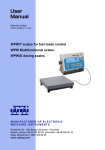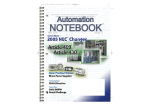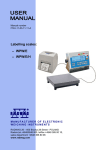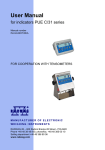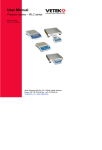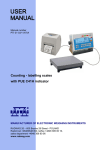Download Manual instruction - Scales for meat industry
Transcript
User Manual Scales for meat industry Manual number: ITKU-21-01-03-10-A • ramp sales • livestock scales • overhead scales • waterproof platform scales MANUFACTURER OF ELECTRONIC WEIGHING INSTRUMENTS RADWAG Wagi Elektroniczne 26 – 600 Radom Bracka 28 Street - POLAND Phone +48 48 38 48 800, phone/fax. +48 48 385 00 10 Selling department +48 48 366 80 06 www.radwag.com MARCH 2010 -2- TABLE OF CONTENTS 1. INTENDED USE .................................................................................................................... 5 2. PRECAUTIONS..................................................................................................................... 6 2.1. Maintenance................................................................................................................... 6 2.2. Accumulator / battery pack............................................................................................. 6 2.3. Operation in a strong electrostatic field .......................................................................... 7 2.4. Scale washing ................................................................................................................ 7 3. WARRANTY CONDITIONS................................................................................................... 9 4. MAIN DIMENSIONS ............................................................................................................ 10 4.1. Ramp scales ................................................................................................................ 10 4.2. Livestock scales ........................................................................................................... 10 4.3. Waterproof platform scales .......................................................................................... 12 5. ASSEMBLY AND LEVELLING ........................................................................................... 13 5.1. Assembly of scales ...................................................................................................... 13 5.2. Levelling the scale........................................................................................................ 16 6. GETTING STARTED ........................................................................................................... 16 7. KEYPAD .............................................................................................................................. 17 8. KEYS’ FUNCTIONS ........................................................................................................... 17 9. INSCRIPTIONS ON THE DISPLAY .................................................................................... 18 10. USER MENU ..................................................................................................................... 19 10.1. Submenus ................................................................................................................. 19 10.2. Browsing user menu .................................................................................................. 20 10.2.1. Keypad ............................................................................................................ 20 10.2.2. Return to the weighing mode .......................................................................... 20 11. WEIGHING ........................................................................................................................ 21 11.1. Tarring ....................................................................................................................... 23 11.2. Inscribing tare value .................................................................................................. 23 11.3. Zeroing ...................................................................................................................... 24 11.4. Weighings in two ranges ........................................................................................... 24 11.5. Selection of basic weight unit .................................................................................... 25 11.6. Temporarily selected unit .......................................................................................... 26 12. MAIN PARAMETERS ........................................................................................................ 27 12.1. Setting a filtering level ............................................................................................... 27 12.2. Median filter ............................................................................................................... 28 12.3. Autozero function....................................................................................................... 29 12.4. Tare function.............................................................................................................. 30 13. RS 232 PARAMETERS ..................................................................................................... 31 13.1. Printout type............................................................................................................... 31 13.2. Minimal mass threshold............................................................................................. 32 13.3. Baud rate ................................................................................................................... 33 13.4. Serial transmission parameters ................................................................................. 34 14. OTHER PARAMETERS .................................................................................................... 35 14.1. Backlight function ...................................................................................................... 35 14.1.1. Backlight for supplying from mains.................................................................. 35 14.1.2. Backlight for supplying from batteries ............................................................. 36 14.2. “Beep” signal – after pressing a key .......................................................................... 37 14.3. Automatic switch-off .................................................................................................. 37 14.4. Battery voltage level check........................................................................................ 38 14.4.1. Checking the batteries..................................................................................... 39 14.4.2. Battery discharge pictogram............................................................................ 39 14.4.3. Accumulator charging option........................................................................... 40 -3- 15. WORK MODES ................................................................................................................. 41 15.1. Setting accessibility of operation modes ................................................................... 41 15.2. Selecting quantity of operation modes ...................................................................... 42 15.3. Counting pieces of the same mass ........................................................................... 43 15.4. +/- control referring to the inscribed standard mass .................................................. 45 15.5. Control of % deviation referring to the inscribed standard mass ............................... 47 15.5.1. Standard mass determined by its weighing..................................................... 47 15.5.2. Mass of standard inscribed to scale memory .................................................. 48 15.6. Automatic tare ........................................................................................................... 49 15.7. Measurement max force on the pan – latch .............................................................. 50 15.8. Totalizing ................................................................................................................... 50 15.8.1. Enabling the work mode.................................................................................. 51 15.8.2. Totalizing procedure ........................................................................................ 51 15.8.3. Memory of the last value of sum of weighed goods ........................................ 52 15.8.4. Return to weighing .......................................................................................... 53 15.9. Weighing animals ...................................................................................................... 54 15.10. Tare memory............................................................................................................ 55 15.10.1. Entering the tare value to the scale memory ................................................ 55 15.10.2. Selecting a tare value from the memory ....................................................... 57 16. USER CALIBRATION ....................................................................................................... 58 16.1. Calibration ................................................................................................................. 58 16.2. Start mass adjustment............................................................................................... 60 17. COOPERATION WITH PRINTER ..................................................................................... 61 18. COOPERATION WITH COMPUTER................................................................................. 62 19. COMMUNICATION PROTOCOL ...................................................................................... 63 19.1. General information ................................................................................................... 63 19.2. A set of commands for RS interfaces ........................................................................ 63 19.3. Respond message format ......................................................................................... 64 19.4. Command’s description ............................................................................................. 64 19.4.1. Zeroing ............................................................................................................ 64 19.4.2. Tarring ............................................................................................................. 64 19.4.3. Get tare value .................................................................................................. 65 19.4.4. Send the stable result in basic unit.................................................................. 65 19.4.5. Send the result immediately in basic unit ........................................................ 66 19.4.6. Send the stable result in current unit ............................................................... 66 19.4.7. Send the result immediately in current unit ..................................................... 67 19.4.8. Switch on continuous transmission in basic unit ............................................. 68 19.4.9. Switch off continuous transmission in basic unit ............................................. 68 19.4.10. Switch on continuous transmission in current unit........................................ 68 19.4.11. Switch off continuous transmission in current unit........................................ 69 19.4.12. Send all implemented commands................................................................. 69 19.5. Manual printouts / automatic printouts....................................................................... 69 19.6. Continuous transmission ........................................................................................... 70 19.7. Configuring printouts ................................................................................................. 71 20. ERROR COMMANDS........................................................................................................ 71 21. TROUBLE SHOOTING ..................................................................................................... 72 22. TECHNICAL PARAMETERS ............................................................................................ 73 22.1. Ramp scales.............................................................................................................. 73 22.2. Livestock scales ........................................................................................................ 74 22.3. Waterproof platform scales........................................................................................ 75 22.4. Overhead scales........................................................................................................ 76 23. ADDITIONAL EQUIPMENT............................................................................................... 77 -4- 1. INTENDED USE Scales are designed for fast and precise measurements of weighed loads masses and direct commercial settlements. Tarring in full weighing range enables to determine net mass of weighed loads. Functions: • • • • • • • • • • • • • • • • • • • • backlight of display level of filtration autozero function setting baud rate of transmission continuous data transmission for RS 232 automatic operation for RS 232 designed printouts designation minimum mass for function operating counting pieces +/- mass control percentage deviation from standard mass latch of maximum scale indication automatic tare memory of tare Memory of 9 tare values inscribing tare value automatic scale switch-off user calibration Totalizing Weighing animals User functions may have attribute of accessibility. For this reason it is possible to adjust scale to individual needs to provide access to only these functions which are currently needed. Attribute determination accessible / inaccessible is possible in user menu and described in further part of manual. -5- 2. PRECAUTIONS 2.1. Maintenance A. Please, read carefully this user manual before and use the device according to its intended use. B. Devices that are to be withdrawn from usage should be sent back to the producer or in case of own utilization do it according to the law. 2.2. Accumulator / battery pack Scales equipped with PUE C/31H and PUE C/31H/Z weighing indicators (stainless steal housing) are devices designed to be supplied from SLA accumulators (Sealed lead acid type) 6V o and capacity 3 to 4Ah charged while connected to mains without stopping operation. The device connected to mains inteligently monitors the battery state and charges it if possible. After sudden lack of power supply from the mains the device automatically switches to accumulator without breaking operation. In case of an elongated storage period in low temperatures, it is not allowed the full discharge of the accompanied batteries. A worn out accumulator can be exchanged to a new one by the authorized service of the manufacturer. The equipment including accumulators does not belong to your regular household waste. The European legislation requires that electric and electronic equipment be collected and disposed separately from other communal waste with the aim of being recycled. Notice: Some symbols on accumulators identify harmful elements/compounds: Pb = lead, Cd = cadmium, Hg = mercury. -6- 2.3. Operation in a strong electrostatic field If the device is about to operate in a strong electrostatic field (e.g. printing houses etc.) it should be connected to the earthing. Connect it to the clamp terminal signed . 2.4. Scale washing Weighing platforms are made of stainless steel (according to standards PN–0H18N9, EN-1.4301, AISI–304) and silicon elements. There is an exception, zinc coated overhead scales and painted livestock scales made of mild constructional steel with aluminium cover plate on the platform, polyester overlays and stainless steel or polyamide glands. Caution: Washing and disinfection agents should be matched to the scale. Platforms of ramp and livestock scales as well as load-bearing structures and weighing tracks of overhead scales can be washed with jet of water (temp. up to +80°C) with an appropriate washing agent. Washing measuring indicators/weighing terminals with the jet of hot water is not allowed. Caution: It is advisable to cover measuring indicators/weighing terminals while washing their surrounding with the jet of water. -7- To wash waterproof platform scales and indicators/terminals neither jet of water nor hot water shall be used, in order not to damage the silicon gaiter that covers the load cell inside the platform and the overlay or glands in the indicator/terminal. To wash pans of platform scales they should be taken off first. Then they can be washed ether with the jet of water or by immersion. Water with detergent Jet of water Hot water –max 80°C Platforms with tracks yes yes yes Indicator/terminal yes no no Platform with railing yes yes yes Indicator/terminal yes no no Load bearing structure with he load cell yes yes yes Indicator/terminal yes no no Platform yes no no Indicator/terminal yes no no Taken off pan yes yes yes Type: Ramp scales Livestock scales Overhead scales Platform waterproof scales -8- 3. WARRANTY CONDITIONS A. RADWAG is obliged to repair or change those elements that appears to be faulty because of production and construction reason, B. Defining defects of unclear origin and outlining methods of elimination can be settled only in participation of a user and the manufacturer representatives, C. RADWAG does not take any responsibility connected with destructions or losses derives from non-authorized or inappropriate (not adequate to manuals) production or service procedures, D. Warranty does not cover: • Mechanical failures caused by inappropriate maintenance of the device or failures of thermal or chemical origin or caused by atmospheric discharge, overvoltage in mains or other random event, • Inappropriate cleaning. E. Loss of warranty appears after: • Access by an unauthorized service, • Intrusion into mechanical or electronic construction of unauthorized people, • Removing or destroying protection stickers. F. Warranty conditions outline the warranty period for rechargeable batteries attached to the device for 12 months. G. The detailed warranty conditions one can find in warranty certificate, H. Contact with the central authorized service: +48 48 384 88 00 ext. 106 or 107. -9- 4. MAIN DIMENSIONS 4.1. Ramp scales 4.2. Livestock scales Scales of WPT/4I 2000S(H)1series - 10 - Scales of WPT/4I 2000S(H)2 series Scales of WPT/4I 2000S(H)3 – series - 11 - 4.3. Waterproof platform scales Scales of WPT…H1 series (extension arm 24cm) Scales of WPT…H1 series (extension arm 7cm) Scales of WPT…H2 - WPT…H6 series - 12 - 5. ASSEMBLY AND LEVELLING 5.1. Assembly of scales A. Overhead scales • Overhead scales are built of bearing elements and load cells as measuring transducers. Scales are installed on a rail of a load -bearing structure. The load cell is installed in the separated section of the track. • Overhead scales can be installed only by authorized services of RADWAG. Otherwise the validity of warranty is automatically lost. Do not introduce any mechanical stresses to the weighing system during installation. • It is forbidden to use any chemical agents comprising penetrators for washing. • The scale should be periodically cleaned from lubricants and impurities (especially the connection between the scale rail and the crane track). B. Livestock scales • Remove the transport protection if installed. • Screw in levelling feet to mandrels placed in load cells • Put the scale in the spot of usage on a flat stable ground. - 13 - C. Ramp scales • Before setting the scale mount the steel camping ring (2) to the basis of feet (1) using expanding ring (3) and then screw in the basis of the foot (1) in the mandrel (4). • Put the scale on the flat ground. Put ramps on steel clamping. Take off ramps and mark (through the holes in clamping) places for drilling holes for anchors. After drilling mount clamping to the ground. 5 - nut 6 - washer 7 – centring washer 8 - anchor - 14 - D. Waterproof platform scales Unpack and put the scale on a flat even stable surface far away from sources of heat and then: • Unscrew the pillar and the transport handler from the platform: • Turn the pillar and mount it to the platform. The surplus cable place inside the pillar: • Pick up the pan and remove the transport protection: - 15 - 5.2. Levelling the scale A. Platform scales After unpacking the scale should be levelled out. Use levelling legs and the level condition indicator installed in the basis of the scale. B. Four load cell scales Level scale by means of turning levelling feet and external level indicator. Put the pads under the regulation legs and observe the level condition indicator. The instrument is levelled correctly if the air bubble do not move more than 2mm from the central position. Each leg can be screwed in and out in order to level the scale. Correct levelling can be done by putting steel pads under the legs. 6. GETTING STARTED After unpacking and mounting (chapter 5 of this manual): • Turn the device on using the the key for about 0.5 sec, key – keep pressing • Wait for the test completion, - 16 - • Then you will see zero indication and pictograms: - zero indication - stable result kg - weight unit • If the indication is not zero press zero key. 7. KEYPAD 8. KEYS’ FUNCTIONS Switching on/off Function key (operation mode selection) Sending a weighing result to RS232 Zeroing Tarring - 17 - Notice: + keys’ functions changes. The way of operation After pressing in this mode is described in details further in this manual. 9. INSCRIPTIONS ON THE DISPLAY No Text string Description 1. FIL Filter level 2. bAud Transmission baud rate 3. PCS Piece counting 4. HiLo +/- control according to a standard mass 5. rEPL Automatic printout 6. StAb The condition of printing data 7. Auto Autozero correction 8. t1 Power save – time to switch off while no operation 9. toP Latch of the max measurement 10. Add Totalizing 11. AnLS Weighing animals 12. tArE Pamięć 9 wartości tar 13. Indication in autozero zone (indication = exact zero) 14. Stable result (ready to read) 15. PCS Operation mode – counting pieces 16. kg (g) Operation mode – weighing Rechargeable battery pack or battery discharged (BAT-LO) 17. 18. Net Tare function has been used 19. Min +/- control with reference to the standard mass : setting the lower threshold or mass below the first threshold 20. OK +/- control with reference to the standard mass: load masa between the thresholds 21. Max +/- control with reference to the standard mass: setting the upper threshold or mass over the second threshold - 18 - 10. USER MENU 10.1. Submenus User’s menu is divided into 6 basic submenus. Each group has its own characteristic name preceded by the letter P and a number. P1 rEAd P 1.1 Fil P 1.2 Auto P 1.3 tArA P 1.4 Fnnd P2 Prnt P2.1 Pr_n P2.2 S_Lo P2.3 bAud P2.4 S_rS P3 Unit P3.1 StUn P4 Func P4.1 FFun P4.2 Funi P4.3 PcS P4.4 HiLo P4.5 PrcA P4.6 Prcb P4.7 AtAr P4.8 toP P4.9 Add P4.A AnLS P4.b tArE P5 othr P5.1 bL P5.2 bLbt P5.3 bEEP P5.4 t1 P5.5 CHr6 P6 CAL P6.1 St_u P6.2 uCAL | | | | 2 YES no no | | | | StAb 9600 8d1SnP | kg | | | | | | | | | | | ALL no no no no no no no no no no | | | | | Auto 70 YES Auto YES | | * FUNCTION * * FUNCTION * - 19 - 10.2. Browsing user menu Use scale’s keys to move inside the menu. 10.2.1. Keypad Entering main menu + + Inscribing tare value Increasing a digit value by „1” moving down in the menu Battery / accumulator state monitoring + Toggling between gross / net values + Selecting the parameter or changing the value of a selected parameter Entering the selected submenu or activating a parameter for changes Confirmation (enter) Leaving without changes or reaching a higher level of the menu 10.2.2. Return to the weighing mode The changes that have been introduced should be saved in order to keep them in the memory for good. While leaving parameters press key until the text <SAuE?> appears on the display. Then press: – to save changes or – to leave without changes. - 20 - 11. WEIGHING Put a load you want to weigh on the weighing pan. When the pictogram appears it means that the result is stable and ready to read. In order to assure long-term operation and appropriate measurements of weighted loads following precautions should be taken into consideration: • Loads should be placed on the pan delicately and carefully in order to avoid mechanical shocks: • Loads should be placed centrally on the pan (errors caused by eccentric weighing are outlined by standard PN-EN 45501 ch. 3.5 and 3.6.2): • Do not load the pan with concentrated force: • Avoid side loads, particularly side shocks should be avoided - 21 - Special line scales should be loaded with intended loads: • For ramp scales (hand trucks used in meat industry) the platform should be matched to the trucks with maximum weight and the wheels were close to the load-bearing sections: • For livestock scales – swine, cattle: − platforms with low railing for swine, − platforms with high railing reinforced connecting links at the top edge. • For overhead scales (goods hung on hooks) adapted to underslung tracks: − Hooks appropriate for the track and scale, − Smooth travelling along the load cell without jerks and movements aside, − Tensometer (load cell) loaded uniformly. - 22 - 11.1. Tarring In order to determine the net mass put the packaging on the pan. (Net pictogram will be displayed in the left After stabilising press upper corner and zero will be indicated). After placing a load on the weight pan net mass will be shown. Tarring is possible within the whole range of the scale. After unloading the pan the display shows the tarred value with minus sign. Notice: Tarring cannot be performer when a negative or zero value is being displayed. In such case <Err3> appears on the display and short audible signal will be emitted. 11.2. Inscribing tare value You can also inscribe a tare value. While in weighings mode press: • Press simultaneously • You will see : and , - 23 - • Using • • , Press Program returns to weighings mode. The inscribed tare value can be seen on the display with „–” sign, Tare can be inscribed anytime in weighings mode. • and set the tare value, Notice: 1. You cannot inscribe a new tare value when the tare value in memory is greater than zero. In the case of trying this the <Err3> message will be displayed and short audible signal will be emitted. 2. Users can also enter up to 9 tare values to the scale memory (see 15.10 of his manual). 11.3. Zeroing To ZERO the scale press: . The scale will display zero and following pictograms: and . Zeroing is only possible within the scope of ±2% of full scale. While zeroing outside the scope of ±2% you will see <Err2>. Zeroing is possible only in stable state. Notice: Zeroing is possible only within the ±2% interval of the maximal range. If zeroing is performed beyond this range the <Err2> message and short audible signal will be emitted. 11.4. Weighings in two ranges Switching between the I range and the II range happens automatically (exceeding Max of the I range). Weighings in the second range is signalled by a pictogram in the top left corner of the display. Then weighings is done with the accuracy of the II range to the moment ) where the scale switches back of returning to zero (autozero range to the I range. - 24 - 11.5. Selection of basic weight unit This function is used to set weight unit the scale will start with. Procedure: • Enter the submenu <P3.Unit> and then: • press , until the expected unit appears on the display: Options: A. When the basic unit is [kg], users can toggle between: [kg, lb, N], for verified scales [lb] is not accessible, B. If the basic unit is [g], users can toggle between: [g, ct, lb], for verified scales [lb] is not accessible, - 25 - • After you select the unit press , the scale returns to: • Return to weighing according to chapter - 10.2.2. Notice: After turning on the scale always sets the basic unit. 11.6. Temporarily selected unit This function is used to set weight unit the scale will use temporarily until the next power off or next selection. Procedure: • Press and then: • After you select the unit you want come back to weighing procedure. - 26 - Options: A. When [kg] is a basic unit, users can select following units: [kg, lb, N], [lb] is not accessible for verified scales; B. When [g] is a basic unit, users can select following units: [g, ct, lb], [lb] is not accessible for verified scales. 12. MAIN PARAMETERS Users can adjust the scale to external ambient conditions (filtering level) or particular needs (autozero operation, tare memory). This parameters are placed in <P1.rEAd> submenu. 12.1. Setting a filtering level Procedure: • Enter the submenu <P1.rEAd> and then: 1 - 4 - level of filtering • By pressing select the filtering level you need. - 27 - Notice: Filtering level influences the time of stabilization. The higher the filtering level is the longer stabilization time is needed. Return to weighing: See - 10.2.2. 12.2. Median filter This filter eliminates short changes (impulses) of measure signal (e.g. shocks). Procedure: • Enter the submenu <P1.rEAd> and then: Fnnd Fnnd no - filter disabled YES - filter enabled Return to weighing: See - 10.2.2. - 28 - 12.3. Autozero function The autozero function has been implemented in order to assure precise indications. This function controls and corrects „0” indication. While the function is active it compares the results continuously with constant frequency. If two sequentional results differ less than the declared value of autozero range, so the scale will be automatically zeroed and will be displayed. and the pictograms When AUTOZERO is disabled zero is not corrected automatically. However, in particular cases, this function can disrupt the measurement process e.g. slow pouring of liquid or powder on the weighing pan. In this case, it is advisable to disable the autozero function. Procedure: • Enter the submenu <P1.rEAd> and then: Fnnd Fnnd no - filter disabled YES - filter enabled Return to weighing: See - 10.2.2. - 29 - 12.4. Tare function This parameters enables users to configure a tare function. Procedure: • Enter the submenu <P1.rEAd> and then: tArA AtAr - automatic tare function on and is stored in balance memory after unplugging it from mains (Description of function operating point 15.6 automatic tare) tArA no - automatic tare function off (user can turn on operating of automatic tare <F6 AtAr> – till unplugging the balance from mains) tArA tArF - tare memory function – stores last value of tare in balance memory. It is automatically displayed after starting the balance. Value of tare is displayed with minus sign, and there is Net symbol indicated on the display. (user can turn on operating of automatic tare F6 AtAr – till unplugging the balance from mains) Return to weighing: See - 10.2.2. - 30 - 13. RS 232 PARAMETERS External devices connected to RS 232C have to be supplied from the same mains and common electric shock protection. It prevents from appearing a potential difference between zero leads of the two devices. This notice does not apply to the devices that do not use zero leads. Transmission parameters: • • • • Baud rate - 2400 – 38400 bit / s Data bits - 7,8 Stop bits - 1,2 Parity control - no, even, odd There are four ways of sending data via RS232 interface: • Manually – after pressing , • Automatically – after stabilizing the indication over LO threshold • Continuously – after it is activated in parameter or by a command sent via RS232 • On external request - see - „List of scale - computer commands”. The indication can be sent as: • stable – the indication is sent after the scale stabilizes. • any – the indication is sent immediately after pressing the this state is assign with <?> in the printout. 13.1. Printout type This parameter is to select the type of printout. Procedure: • Enter the submenu <P2.Prnt> and then: - 31 - key, Pr_n noStAb - Pr_n Pr_n Pr_n Pr_n StAb rEPL CntA Cntb - immediate printout (not accessible in verified scales) sending stable results automatic operation continuous transmission in basic unit continuous transmission in present unit Return to weighing: see 10.2.2. 13.2. Minimal mass threshold This function is necessary while working with automatic tare or automatic operation or weighing animals. Automatic tarring will not be applied until the indication (gross) is lower than the value inscribed in S_Lo parameter. In automatic operation measurements (net) are sent via RS232 when the indication is equal or greater than the value inscribed in S_Lo parameter. Weighings animals is performer when the indication is equal or greater than the value inscribed in S_Lo parameter. Procedure: • Enter the submenu <P2.Prnt> and then: - 32 - Return to weighing: see 10.2.2. 13.3. Baud rate Procedure: • Enter the submenu <P2.Prnt> and then: - 33 - Return to weighing: see 10.2.2. 13.4. Serial transmission parameters Procedure: • Enter the submenu <P2.Prnt> and then: 7d2SnP 7d1SEP 7d1SoP 8d1SnP 8d2SnP 8d1SEP 8d1SoP - 7 data bits; 2 stop bits, no parity control - 7 data bits; 1 stop bit, EVEN parity control - 7 data bits; 1 stop bit, ODD parity control - 8 data bits; 1 stop bit, no parity control - 8 data bits; 2 stop bits, no parity control - 8 data bits; 1 stop bit, EVEN parity control - 8 data bits; 1 stop bit, ODD parity control Return to weighing: See 10.2.2. - 34 - 14. OTHER PARAMETERS The user can set parameters which influence the scale operation. They are gathered in the submenu P5. Othr e.g. backlight and beep signal. Enter this submenu P5. Othr according to chapter 10.2. 14.1. Backlight function Program recognises the way the scale is supplied (mains, battery) and automatically selects the way of operating on the backlight: bl blbt – for mains – for batteries or rechargeable battery pack 14.1.1. Backlight for supplying from mains Procedure: • Enter the submenu <P5.othr> and then: bL bL bL no YES Auto - backlight switched off backlight switched on backlight switched off automatically if indication becomes stable for about 10s - 35 - Return to weighing: See 10.2.2. Notice: When bl=Auto, and the indication has not changed for 10s, the backlight is automatically switched off. The backlight is switched on again automatically after the result changes. 14.1.2. Backlight for supplying from batteries The user can change the intensity of backlight from 0% to 100%. The lower the intensity is the longer the scale operates without recharging or exchanging batteries. When the intensity is set this function works as AUTO (described above). Procedure: • Enter the submenu <P5.othr> and then: Return to weighing: See 10.2.2. Notice: The more intense the backlight is the shorter the scale operates on batteries. - 36 - 14.2. “Beep” signal – after pressing a key Procedure: • Enter the submenu <P5.othr> and then: bEEP bEEP no - switched off YES - switched on Return to weighing: See 10.2.2. 14.3. Automatic switch-off This function is essential to save the battery power. The scale is switched off automatically when (function t1 = YES) no weighing appears in 5 minutes. (no changes on the display). In case when this function disrupts the operation (e.g. long time weighing procedures) or while working with connection to mains, switch off this function. - 37 - Operation according to the power supply: Operation Setting t1 = 0 Mains Batteries/accumulator disabled disabled t1 = YES enabled enabled t1 = Auto * disabled enabled * automatic enabling/disabling according to the source of power. Procedure: • Enter the submenu <P5.othr> and then: Returnto weighing: See 10.2.2. 14.4. Battery voltage level check While supplying from batteries too low level of voltage is measured is displayed. It means that charging by software the pictogram or exchanging batteries is required. - 38 - 14.4.1. Checking the batteries This function is to check the level of battery supply. It works only if: • Weighing mode is set, • Battery supply is set in parameters. Procedure: After displaying the level of batteries (in per cents) the program returns to weighing. 14.4.2. Battery discharge pictogram The symbol (bat low) switches on when the voltage level drops to 18% of the accepted level of voltage. It means that charging or exchanging batteries is required. Low level of batteries: • Pictogram • After one time the device will automatically switch off to protect the batteries from distructable discharging, • Charging is signalled by 2 seconds) on the display. on the display, (blinking period about - 39 - 14.4.3. Accumulator charging option This function allows to switch on the charging algorithm for SLA jell cell battery: a) Parameter <CHr6> set to <no>: does not appear, charging disabled. • Pictogram • During software initializing, after turning on <bAtt>. b) Parameter <CHr6> set to <YES>: • blinks slowly (period about 2 seconds), Pictogram charging is enabled. • Message <SLA> appears on the display, • In case of damaging accumulators or lack of it the pictogram blinks quickly (period about 0.5 sec). Notice: Standard scales are equipped in an SLA jell cell battery pack and a power adapter. Procedure: • Enter the submenu <P5.othr> and then: - 40 - CHr6 YES CHr6 no - enabled - disabled Return to weighing: See 10.2.2. 15. WORK MODES 15.1. Setting accessibility of operation modes In this parameter group users can disable/enable accessibility of functions after pressing key. Procedure: • Enter the submenu <P4.Func> and then: no YES – mode is disabled – mode is enabled Return to weighing: See 10.2.2. - 41 - 15.2. Selecting quantity of operation modes This function enables user to set if ,after pressing key, all operating modes will be accessible (ALL) or only one from the list chosen and used by operator. Procedure: • Enter the submenu <P4.Func> and then: key. The program will return After choosing setting press to displaying name of submenu <P4.1.FFun>. Return to weighing: See 10.2.2. - 42 - 15.3. Counting pieces of the same mass Standard solution is equipped with option of counting small pieces of the same mass. It is possible to execute a tare function in this operating mode in order to tare a container value. Notice: 1. Counting pieces does not work together with other scale functions, 2. The counting pieces function is not saved as a default start function so it is not remembered after restarting. Procedure: • Enter to <PcS> function: • You will see a blinking value of sample quantity. key to start setting quantity of sample, you have a few • Press options to chose from: - 43 - • If option <LASt> is choosen in the scale program displays estimated unit mass of the last piece (about 3 sekonds) and then goes to Counting pieces automatically setting the previously displayed value as valid for the procedure. • If the <FrEE> option is selected you will see: • Using where: and enter the required sample quantity, - selection of digit position, • Confirm the value by pressing - setting the digit, , • You will see <LoAd> on the display and then: • If weighing is performed in a container put the container on the pan first and then tare it. Then put the declared quantity of pieces on the pan and confirm it when stable (signalled by ): • The program will automatically calculate the mass of a single piece and go on to the Piece Counting mode (pcs). You will see the following display: - 44 - Notice: key when load is not present on the pan, 1. If a user presses the the message -Lo- will be indicated for a few seconds and the scale will automatically return to weighing. 2. In order to comply with the rules of appropriate counting pieces put as many pieces as possible during unit mass adjustment. Single piece mass should not be less than 5 divisions. 3. If a single piece mass is lower than a reading interval d the display will show the <Err5> message (see ch. 20. Error messages) and short audible signal will be emitted than the scale returns to weighing. Return to weighing: • Press the key twice. 15.4. +/- control referring to the inscribed standard mass Procedure: • Enter to <HiLo> function: • The program enters the window of setting the lower threshold of weighing (Min): - 45 - • The inscribed value confirm by pressing , the program will automatically go to the higher threshold of weighing (Max): • The inscribed value confirm by pressing automatically go to the main window. , the program will • During setting threshold values following cases take place: Notice: If a user erroneously enters a value of the lower threshold higher than the upper one, the scale will indicate an error message and will return to weighing. - 46 - Return to weighing: • Press the key twice. 15.5. Control of % deviation referring to the inscribed standard mass Scale software enables control of deviation (in %) of weighed loads mass referring to the inscribed standard mass. Mass of standard can be determined by its weighing (PrcA function) or entered to the scale memory by an user (PrcB function). 15.5.1. Standard mass determined by its weighing Procedure: • Enter to <PrcA> function: • You will see <LoAd> on the display and then: • place an load on the pan which mass will be accepted as standard to confirm this operating mode • press • after few seconds the indication 100,00% will be displayed • From this moment display will not indicate mass of weighed load but deviation of load mass placed on the pan referring to the mass of standard (in %). - 47 - Return to weighing: • Press the key twice. 15.5.2. Mass of standard inscribed to scale memory Procedure: • Enter to <PrcB> function: • The program goes to the weight display window: • Using where: and set standard mass, - digit selection, - digit setting. , • Confirm the entered value by pressing • You will see the indication equal to 0,000%, • From this moment display will not indicate the mass of weighed load but deviation of the load mass placed on the pan referring mass of standard (in %). - 48 - Return to weighing: • Press the key twice. 15.6. Automatic tare This function is useful for fast net mass determination of weighed load in case when tare value of is different for each load. In case when the function is active the cycle of scales operating looks as follows: • press zeroing key when the pan is empty, • place the container for pieces, • when indication is stable automatic tarring of the container mass will be performed (Net marker will appear in the upper part of the display), • place a sample into the package, • display will indicate net mass of sample, • remove the sample together with the container, • display will indicate tare mass with minus sign, • place a container for the next sample. When indication is stable automatic tarring will take place (Net marker will appear in the upper part of the display), • place next sample into the package. Procedure: Return to weighing: • Press the key twice. - 49 - 15.7. Measurement max force on the pan – latch Procedure: • Enter to <toP> function: • Confirmation of choice of <toP> function is indication of the Max pictogram: • Apply a force to the weighing pan. • The display of scale will latch the maximum value of the force • Remove loads from the pan • Before the next measurement press the key. Return to weighing: • Press the key twice. 15.8. Totalizing Scale software is equipped in a totalizing function of single weighings. The totalizing procedure can be documented on the printer connected to the indicator. - 50 - 15.8.1. Enabling the work mode Procedure: • Enter to <Add> function: • A letter „P” in the left side of the display is a confirmation that <Add> function have been selected: 15.8.2. Totalizing procedure • Enter <Add> function according to ch. 15.8.1, • Put the first load on the pan. If the weighing procedure is performed in a container put the container on the pan first and tare it. Then put the first load on the pan and confirm it by pressing when stable ):, (signalled by • You will see a sum of weighings on the display, the „▲” pictogram in the upper right corner will be displayed and the weighing result will be printed on the printer connected to the indicator. - 51 - • Take off the load from the pan, indication returns to ZERO and the letter „P” in the left part of the display appears, • Put the next load on the pan, , the sum of first and second weighing • After stabilizing press will appear on the display, the „▲” pictogram in the upper right corner will be displayed and the second weighing result will be printed on the printer connected to the indicator: to complete the procedure (with the loaded or unloaded • Press pan), a sum of all weighings will be printed: (1) 1.912 kg (2) 1.912 kg -----------------------TOTAL: 3.824 kg one more time with loaded pan, you will • In case of pressing see the <unLoAd> message. Unload the pan, the scale will return to ZERO and the letter „P” in the left part of the display will appear. The scale is ready for the next procedure. one more time with loaded pan, you will • In case of pressing see the letter „P” in the left part of the display will appear. The scale is ready for the next procedure. 15.8.3. Memory of the last value of sum of weighed goods After interrupting (e.g. switching off) the totalizing procedure, it is possible to restart the procedure without loosing data. In order to do it just enter the totalizing procedure: • Enter <Add> function again according to the ch. 15.8.1 of the manual, • You will see the last memorized sum of weighings on He display. - 52 - - In order to continue the procedure press , the indication returns to ZERO and the letter „P” appears in the left part of the display. The scale is ready for weighing. - In order to terminate the previous totalizing procedure press key, , or . You will see the letter „P” in the left part of the display. The scale is ready for weighing. 15.8.4. Return to weighing • Press key, you will see: • Before leaving the <Add> function it is possible to print out subsequent weighings and the sum of weighings on the connected printer (press to print, press to cancel), • The following message will appear on the display: • Press key to return to weighing, • Press to return to totalizing. Notice: In case of overflow of the range of the display in totalizing you will see <5-FULL> message in the display. In that case unload the pan and press PRINT to complete the procedure with a printout of sum of all weighings or put a lower mass on the pan which does not cause the overflow error. - 53 - 15.9. Weighing animals Procedure: • Enter to <AnLS> function: • The <tinnE> message appears on the display for 1s, and then the program goes to the window of setting the duration time (in seconds) of the animal weighing process: • Confirm the selected value by pressing • You will see the following window: - 54 - , • Load an animal to the platform, • After exceeding the -LO- value (see 13.2), program starts the weighings process. The appearance of subsequent hyphens < - - - - - - - > showing the progress, • After completing the process of weighings the result is latched on the display and additionally the OK pictogram is shown in the upper part of the display: • You can start the procedure of weighing animals again by pressing • , After removing the animal from the platform program returns to the window: Return to weighing: • Press . 15.10. Tare memory Users are allowed to Enter Up to 9 tare values to the memory. 15.10.1. Entering the tare value to the scale memory Procedure: • Enter to <tArE> function: - 55 - • The program goes to displaying the first value from the selection of tare values <tArE 0> (press to chose different values): • After selecting the right position press an editing field: and you will see • Enter the selected tare value to the scale memory • The program returns to the following window: - 56 - , Return to weighing: • Press . 15.10.2. Selecting a tare value from the memory • Enter <tArE> function according to the ch. 15.10.1 of the manual, • The program goes to displaying the first value from the selection of tare values <tArE 0> (press to chose different values): • To use an entered tare value press , you will see the tare value on the display preceded by the „-„ sign and the Net pictogram: Caution: A tare value from the memory is not remembered after powering off and on the scale. - 57 - 16. USER CALIBRATION Only for non-verified scales Confirmation of high accuracy of weighing requires periodical correcting of calibration factors in the scale memory – this is adjustment of the scale. Calibration should be performed when we start weighing or dynamic change of temperature occurs. Before starting calibration remove loads from the pan. 16.1. Calibration Procedure: • Enter the submenu <P6.CAL> and then: • Following inscriptions will appear • A new start mass is adjusted during this period of time. After that a mass of calibration weight is shown (e.g. 3 000kg). - 58 - • Put a weight of the displayed mass value on the pan and press . The calibration process will start which is signalled by the message: • After completion of the process of calibration the following screen will appear • Take off the weight , then the following sequence of screens will appear • Calibration process can be terminated anytime by pressing which is signalled by the following message on the display: • Return to weighing with saving changes that have been made. Caution: If the calibration process (span adjustment) lasts longer than 15 the <Err8> message will be displayed and short audible signal will be to perform calibration again with more stable emitted. Press ambient conditions! - 59 - 16.2. Start mass adjustment If the scale does not require the full calibration process sit is possible to adjust only a new start mass. Procedure: • Enter the submenu <P6.CAL> and then: • The display will show the following information • After the completion of the start mass adjustment the following screen will appear: • The process of start mass adjustment can be terminated by pressing , which is signalled on the display: - 60 - • Return to weighing performing the procedure of saving parameters. Caution: If the start mass adjustment lasts longer than 15 the <Err8> message will be displayed and short audible signal will be emitted. Press to perform calibration again with more stable ambient conditions! 17. COOPERATION WITH PRINTER key is pressed a current mass value together with Each time the mass units is sent to RS 232 interface. Depending on setting of STAB parameter it can be printed out with temporary or stable value. Depending on setting of REPL parameter, printout will be automatic or manual. One of thermal printer in KAFKA series can cooperate with each platform scales: a) KAFKA Only result of weighing with mass unit can be printed. b) KAFKA 1/Z This printer is equipped with an internal real time clock. Both date and time can be printed. c) KAFKA SQ S This printer is equipped with an internal real time clock and possibility of running statistics from measurements. Statistic contents: quantity of samples, sum of masses of all samples, average value, standard deviation, variation factor, min value, max value, difference max - min. - 61 - Cable diagrams: Scale – Kafka printer cable diagram 18. COOPERATION WITH COMPUTER Sending weighing results to the computer can be done: - manually - in continuous way - - automatically - on the request from the computer - after pressing key, after function activating or sending an appropriate command, After stabilizing the indication - After sending a control command These scales can cooperate with „EDYTOR WAG” program. The indicator window comprises the most important information from the scale display. The program allows to configure easily, e.g. design printouts, edit parameters. A precise description is issued in the „Help” file that accompanies the program. Cable diagrams: Scale – computer cable diagram - 62 - 19. COMMUNICATION PROTOCOL 19.1. General information A. A character protocol scale-terminal has been designed for communication between RADWAG scales and external devices via RS-232 interface. B. It consists of commands sent from an external device to the scale and a responses from a scale. C. Responses are sent every time after receiving a command (reaction for any command). D. Using commands allows users to receive some information about the state of scale and/or influence the operation e.g.: • Requesting weighing results, • Display control. 19.2. A set of commands for RS interfaces Commands Description of commands Z Zeroing T Tarring TO Get tare S Send the stable result in basic unit SI Send the result immediately in basic unit SU Send the stable result in current unit SUI Send the result immediately in current unit C1 Switch on continuous transmission in basic unit C0 Switch off continuous transmission in basic unit CU1 Switch on continuous transmission in current unit CU0 Switch off continuous transmission in current unit PC Send all implemented commands Notice: 1. Each command have to be terminated in CR LF; 2. The best Policy for communication is not sending another command until the former answer has been received. - 63 - 19.3. Respond message format After sending a request message you can receive: XX_A CR LF command accepted and in progress XX_D CR LF command completed (appears only after XX_A) XX_I CR LF command comprehended but cannot be executed XX _ ^ CR LF command comprehended but time overflow error appeared XX _ v CR LF command comprehended but the indication below the XX _ OK CR LF Command done ES_CR LF Command not comprehended XX _ E CR LF error while executing command – time limit for stable result exceeded (limit time is a descriptive parameter of the scale) XX _ - command name - substitutes spaces 19.4. Command’s description 19.4.1. Zeroing Syntax Z CR LF Possible answers: Z_A CR LF Z_D CR LF - command accepted and in progress - command completed Z_A CR LF Z_^ CR LF - command accepted and in progress - command comprehended but zero range overflow appeared Z_A CR LF Z_E CR LF - command accepted and in progress - time limit for stable result exceeded Z_I CR LF - command comprehended but cannot be executed 19.4.2. Tarring Syntax: T CR LF Possible answers: - 64 - T_A CR LF T_D CR LF - command accepted and in progress - command completed T_A CR LF T_v CR LF - command accepted and in progress - command comprehended but tare range overflow appeared T_A CR LF T_E CR LF - command accepted and in progress - time limit for stable result exceeded T_I CR LF - command comprehended but cannot be executed 19.4.3. Get tare value Syntax: TO CR LF Possible answers: TO_TARA CR LF - command executed Frame format: 1 2 3 4 5-6 7-15 16 T O space stability space tare space Tare Unit 17 18 19 unit 20 21 CR LF - 9 characters with decimal point justified to the right - 3 characters justified to the left 19.4.4. Send the stable result in basic unit Syntax: S CR LF Possible answers: S_A CR LF S_E CR LF - command accepted and in progress - time limit for stable result exceeded S_I CR LF - command comprehended but cannot be executed S_A CR LF MASS FRAME - command accepted and in progress - mass value in basic unit is returned - 65 - Frame format: 1 2-3 4 5 6 7-15 16 S space stability space sign mass space 17 18 19 unit 20 21 CR LF Example: S CR LF – computer command S _ A CR LF - command accepted and in progress S _ _ _ _ - _ _ _ _ _ _ 8 . 5 _ g _ _ CR LF – command done, mass value in basic unit is returned. 19.4.5. Send the result immediately in basic unit Syntax: SI CR LF Possible answers: SI_I CR LF MASS FRAME - command comprehended but cannot be executed at the moment - mass value in basic unit is returned Frame format: 1 2 3 4 5 6 7-15 16 S I space stability space sign mass space 17 18 19 unit Example: S I CR LF – computer command S I _ ? _ _ _ _ _ _ _ 1 8 . 5 _ k g _ CR LF - command done, mass value in basic unit is returned immediately. 19.4.6. Send the stable result in current unit Syntax: SU CR LF Possible answers: - 66 - 20 21 CR LF SU_A CR LF SU_E CR LF - command accepted and in progress - timeout while waiting for stable results SU_I CR LF - command comprehended but cannot be executed SU_A CR LF MASS FRAME - command accepted and in progress - mass value in current unit is returned Frame format: 1 2 3 4 5 6 7-15 16 S U space stability space sign mass space 17 18 19 unit 20 21 CR LF Example: S U CR LF – computer command S U _ A CR LF - command accepted and in progress S U _ _ _ - _ _ 1 7 2 . 1 3 5 _ N _ _ CR LF - command done, mass value in current unit is returned. 19.4.7. Send the result immediately in current unit Syntax: SUI CR LF Possible answers: SUI_I CR LF - command comprehended but cannot be executed MASS FRAME - mass value in current unit is returned immediately Frame format: 1 2 3 4 5 6 7-15 16 S U I stability space sign mass space 17 18 19 unit Example: S U I CR LF – computer command S U I ? _ - _ _ _ 5 8 . 2 3 7 _ k g _ CR LF - command executed and mass returned - 67 - 20 21 CR LF 19.4.8. Switch on continuous transmission in basic unit Syntax: C1 CR LF Possible answers: C1_I CR LF - command comprehended but cannot be executed C1_A CR LF MASS FRAME - command comprehended and in progress - mass value in basic unit is returned Frame format: 1 2 3 4 5 6 7-15 16 S I space stability space sign mass space 17 18 19 unit 20 21 CR LF 20 21 CR LF 19.4.9. Switch off continuous transmission in basic unit Syntax: C0 CR LF Possible answers: C0_I CR LF - command comprehended but cannot be executed C0_A CR LF - command comprehended and executed 19.4.10. Switch on continuous transmission in current unit Syntax: CU1 CR LF Possible answers: CU1_I CR LF - command comprehended but cannot be executed CU1_A CR LF MASS FRAME - command comprehended and in progress - mass value in current unit is returned Frame format: 1 2 3 4 5 6 7-15 16 S U I stability space sign mass space - 68 - 17 18 unit 19 19.4.11. Switch off continuous transmission in current unit Syntax: CU0 CR LF Possible answers: CU0_I CR LF - command comprehended but cannot be executed CU0_A CR LF - command comprehended and executed 19.4.12. Send all implemented commands Syntax: PC CR LF Possible answers: PC_- >_Z,T, TO,S,SI,SU,SUI,C1,C0,CU1,CU0,PC – command executed, the indicator have sent all the implemented commands. 19.5. Manual printouts / automatic printouts Users can general manual or automatic printouts from the scale. • Manual printouts can be performed after loading the pan . and stabilizing indication by pressing • Automatic printouts can be performed only after loading the pan and stabilizing indication. Notice: If a scale is verified printouts of immediate values are blocked. Format frame: 1 2 3 4 -12 13 stability space sign mass space - 69 - 14 15 unit 16 17 18 CR LF Stability character sign mass unit command [space] if stable [?] if not stable [^] if an indication over the range [v] if fan indication below the range [space] for positive values or [-] for negative values 9 characters justified to the right 3 characters justified to the left 3 characters justified to the left Example 1: _ _ _ _ _ _ 1 8 3 2 . 0 _ g _ _ CR LF – the printout generated from the scale after pressing ENTER/PRINT. Example 2: ? _ - _ _ _ _ 2 . 2 3 7 _ l b _ CR LF - the printout generated from the scale after pressing ENTER/PRINT. Example 3: ^ _ _ _ _ _ _ 0 . 0 0 0 _ k g _ CR LF - the printout generated from the scale after pressing ENTER/PRINT. 19.6. Continuous transmission The indicator can work in a continuous transmission mode. It can be switched on or off in parameters or using RS232 commands. The frame format sent by the indicator in case of setting <P2.Prnt> to CntA: 1 2 3 4 5 6 7-15 16 S I space stability space sign mass space - 70 - 17 18 Unit 19 20 21 CR LF Stability character sign mass unit command [space] if stable [?] if not stable [^] if an indication over the range [v] if fan indication below the range [space] for positive values or [-] for negative values 9 characters justified to the right 3 characters justified to the left 3 characters justified to the left The frame format sent by the indicator in case of setting <P2.Prnt> to Cntb: 1 2 3 4 5 6 7-15 16 S U I stability space sign mass space 17 18 19 unit 20 21 CR LF 19.7. Configuring printouts General information If some information included are redundant or not sufficient and there is a necessity of changes one can design their own protocol format in EDYTOR WAG computer program. This piece of software is accessible in: http://www.radwag.com 20. ERROR COMMANDS Err2 - Value beyond the zero range Err3 - Value beyond the tare range Err4 - Calibration mass or start mass beyond the acceptable range (±1% for weight, ±10 for start mass) Err5 - Mass of a single piece lower than the scale division Err8 - Exceeded the time for tarring, zeroing, start mass adjustment or span adjustment - 71 - NULL - Zero value from the AD converter FULL2 - Measurement range overflow LH - Start mass error, the mass on the weighing platform is beyond the acceptable range (-5% to +15% of start mass) 5-FULL - Display range overflow in totalizing Notice: 1. Errors: Err2, Err3, Err4, Err5, Err8, null, that appear on the display are also signalled by a short beep sound (about 1 sec.); 2. Error FULL2 that appears on the display is also signalled by a continuous sound until the cause of error disappears. 21. TROUBLE SHOOTING Problem Turning on does not work The scale turns off automatically Cause Solution Discharged batteries. Connect to mains or change batteries No batteries (not installed or improperly installed) Check the correctness of installation (polarization) „t1” set to „YES” (Power save) In „othr” submenu change „5.4 t1” to „no” After turning on „LH” Loaded weight pan during message on the display powering up - 72 - Unload the pan. Then the scale will indicator zero. 22. TECHNICAL PARAMETERS 22.1. Ramp scales Scale type: WPT/4N 400H1 WPT/4N 400H2 WPT/4N 800H2 WPT/4N 800H3 Max capacity 400kg 800kg Min capacity 4kg 10kg Readability 200g 500g Verification division 200g 500g Range of tare - 400kg Operation temperature Ingress protection rating Power supply Supplied from batteries IP 68 platform, IP 66/67 indicator 230V AC, 50Hz / 11V AC and internal gell cell SLA 6V accumulator Average operation when supplied from batteries 45h Display Platform size LCD with backlight 840 x 860mm Weight of scale with indicator Dimensions of weight [mm] Scale type: - 800kg -10°C to +40°C 1,1 x 1,2m 1,1 x 1,2m 1710x1160x76 WPT/4N 1500H2 Max capacity 180kg 2050x1420x76 WPT/4N 1500H3 10kg Readability 500g Verification division -1500kg Operation temperature -10°C to +40°C Ingress protection rating IP 68 platform, IP 66/67 indicator 230V AC, 50Hz / 11V AC and internal gell cell SLA 6V accumulator Average operation when supplied from batteries 45h Display Platform size Weight of scale with indicator Dimensions of weight [mm] WPT/4N 1500H4 500g Range of tare Supplied from batteries 2350x1520x76 1500kg Min capacity Power supply 1,2 x 1,5m 105kg LCD with backlight 1,1 x 1,2m 1,2 x 1,5m 190kg 230kg 270kg 2150x1420x77 2450x1520x77 2450x1820x77 - 73 - 1,5 x 1,5m 22.2. Livestock scales Scale type: WPT/4I 2000 S1 WPT/4I 2000 S2 Max capacity 2000kg Min capacity 20kg Readability 1kg Verification division 1kg Range of tare -2000kg Operation temperature Ingress Protection Rating Power supply Supplied from batteries WPT/4I 2000 S3 -10°C to +40°C IP 67 – platform, IP 66/67 - indicator 230V, 50 Hz and internal gell cell SLA 6V accumulator Average operation when supplied from batteries 45h Display LCD with backlight Bridge dimension 1 × 2m 1 × 2m 1 × 2,5m Guard-railing size 1,1m 1,8m 1,8m Weight of scale with indicator 290kg 400kg 500kg WPT/4I 2000 H1 WPT/4I 2000 H2 WPT/4I 2000 H3 Scale type: Max capacity 2000kg Min capacity 20kg Readability 1kg Verification division 1kg Range of tare -2000kg Operation temperature Ingress Protection Rating Power supply Supplied from batteries -10°C to +40°C IP 68 – platform, IP 66/67 - indicator 230V, 50 Hz and internal gell cell SLA 6V accumulator Average operation when supplied from batteries 45h Display LCD with backlight Bridge dimension 1 × 2m 1 × 2m Guard-railing size 1,1m 1,8m 1,8m Weight of scale with indicator 290kg 400kg 500kg Notice: − ,,S” option – scales made of powder painted steel (black), − ,,H” option – scales made of powder stainless steel. - 74 - 1 × 2,5m 22.3. Waterproof platform scales WPT 3H1 WPT 6H2 WPT 15H2 WPT 15H3 WPT 30H3 WPT 3H1/K WPT 6H2/K WPT 15H2/K WPT 15H3/K WPT 30H3/K Max capacity 3kg 6kg 15kg 15kg 30kg Min capacity 1g 2g 5g 5g 10g -3kg -6kg -15kg -15kg -30kg Scale type: Tare range Platform size 200×150mm 250 × 300mm Work temperature -10°C to +40°C Ingress protection rating IP 67 - platform, IP 66/67 - indicator 230V AC, 50Hz / 11V AC and internal gell cell SLA 6V accumulator Power supply Supplied from batteries Average operation when supplied from batteries 45h Display Net / Gross weight Package dimensions Scale type: Max capacity Min capacity Tare range Platform size LCD with backlight 7 / 8,3kg 9 / 10,3kg 15,5 / 17,3kg 520x260x290 580x320x360mm 670x510x330mm WPT 60H3 WPT 150H3 WPT 60H4 WPT 150H4 WPT 60H3/K WPT 150H3/K WPT 60H4/K WPT 150H4/K 60kg 150kg 60kg 150kg 20g 50g 20g 50g -60kg -150kg -60kg -150kg 410 × 410mm Work temperature Ingress protection rating Power supply Supplied from batteries Package dimensions 500 × 500mm -10°C to +40°C IP 67 - platform, IP 66/67 - indicator 230V AC, 50Hz / 11V AC and internal gell cell SLA 6V accumulator Average operation when supplied from batteries 45h Display Net / Gross weight 410 × 410mm LCD with backlight 15,5 / 17,3kg 23,5 / 25,8kg 670x510x330mm 520x260x290mm - 75 - WPT 60H5 WPT 150H5 WPT 300H5 WPT 150H6 WPT 300H6 WPT 60H5/K WPT 150H5/K WPT 300H5/K WPT 150H6/K WPT 300H6/K Max capacity 60kg 150kg 300kg 150kg 300kg Min capacity 20g 50g 100g 50g 100g -150kg -300kg -150kg -300kg Scale type: Tare range Platform size -60kg 600 × 600mm Work temperature Ingress protection rating Power supply Supplied from batteries -10°C to +40°C IP 67 - platform, IP 66/67 - indicator 230V AC, 50Hz / 11V AC and internal gell cell SLA 6V accumulator Average operation when supplied from batteries 45h Display Net / Gross weight Package dimensions 800 × 800mm LCD with backlight 29,5 / 31,8kg 42,5 / 45,8kg 840x700x400mm 1160x820x340mm 22.4. Overhead scales Scale type: WPT/2K 300/600 WPT/2K 300/600H Max capacity 600kg Min capacity 2kg Readability 100/200g Tare range -600kg OIML class III Rail length Max 800mm Ingress protection rating Made of IP 65 IP 67/IP 68 Zinc coating steel Stainless steel Work temperature Power supply Supplied from batteries -10°C to +40°C 230V AC, 50Hz / 11V AC and internal gell cell SLA 6V accumulator Average operation when supplied from batteries 45h Display LCD with backlight - 76 - 23. ADDITIONAL EQUIPMENT Accessories: • • • • • • • • • • • • • • • • KAFKA printer cable for PUE C/31H, PUE C/31H/Z - P0253, Computer cable for PUE C/31H, PUE C/31H/Z - P0259, EPSON printer cable for PUE C/31H, PUE C/31H/Z - P0261, Power cord for car lighter 12V DC for PUE C/31H/Z - K0042, Thermal printer - KAFKA, Dot matrix printer - EPSON, Additional display in stainless metal housing for PUE C/31H, PUE C/31H/Z - WD- 4/3 (accessible with balance as complete set only), Large size display (2”) for PUE C/31H, PUE C/31H/Z - WWG-2, Current loop in metal housing PUE C/31H, PUE C/31H/Z - AP2-3 (accessible with balance as complete set only), RS232 / Ethernet converter for PUE C/31 H, PUE C/31H/Z - KR-04, Anti-dust case for Epson printer, A rack for PUE C/31, PUE C/31H or PUE C/31H/Z indicator, A table for a scale (3 versions, for WPT/H3, WPT/H4 and WPT/H5), Stainless steel anti-vibration table - SAP/N, Inroads for low profile scales, Roller table. Computer programs: • “EDYTOR WAG” computer program, • "RAD-KEY" computer program, • "PW-WIN" computer program. - 77 - MANUFACTURER OF ELECTRONIC WEIGHING INSTRUMENTS RADWAG WAGI ELEKTRONICZNE 26 – 600 Radom, Bracka 28 Street POLAND Tel. +48 48 38 48 800, tel./fax. + 48 48 385 00 10 Selling departament + 48 48 366 80 06 www.radwag.com - 78 -














































































